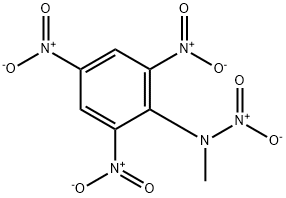테트릴 C화학적 특성, 용도, 생산
개요
This fully reduced quinoline type alkaloid has recently been obtained from the
above-ground parts of Nitraria schoberi. The structure has been determined by
ultraviolet, infrared, NMR and mass spectrometry. One hydroxyl and one methyl
group are present and the alkaloid may be dehydrogenated in the presence of
Pd-C to furnish 8-methylquinoline.
화학적 성질
Tetryl is a colorless to yellow, odorless crystalline solid. High explosive material.
용도
Tetryl is used as an initiator for many less sensitive explosives. It is used as the booster in artillery ammunition. A combination of Tetryl with trinitrotoluene and a small amount of graphite is known as Tetrytol, an explosive used as the bursting charge in artillery ammunition. It is also used as an indicator.
Tetryl is made by reacting 2,4-dinitrochlorobenzene with methylamine and nitrating the product with nitric acid and sulfuric acid.
정의
ChEBI: A nitramine that is methylamine in which one of the hydrogens attached to the nitrogen is substituted by a nitro group while the other is substituted by a 2,4,6-trinitrophenyl group. A yellow crystalline powder, it is a high explosive, capable of being det
nated by friction, shock, or a spark.
일반 설명
A yellow crystalline solid high explosive. Toxic by ingestion and skin absorption. A skin irritant. Will explode if heated above 370°F. Used as a detonating explosive. The primary hazard is the blast of an instantaneous explosion and not flying projectiles and fragments.
반응 프로필
During the measurement of the shock sensitivity of a mixture containing hydrazine, a drop of the hydrazine mixture fell on a TETRYL explosive. The TETRYL immediately burst into flames (ASESB 105).
위험도
Dangerous fire and explosion risk. Skin
irritant, absorbed by skin. Upper respiratory tract
irritant.
건강위험
There is very little information on the human toxicity of this compound. A dose of 5000 mg/kg given subcutaneously was lethal to dogs (NIOSH 1986).
화재위험
MAY EXPLODE AND THROW FRAGMENTS 1600 meters (1 MILE) OR MORE IF FIRE REACHES CARGO.
Safety Profile
Mutation data reported. An irritant, sensitizer, and allergen. The chief effect from exposure is dermatitis. Conjunctivitis is followed by iridocyclitis, and keratitis can occur. Sensitization produced by exposure may play a part in these symptoms. Gastrointestinal effects and anemia have also been reported. A powerful oxidant. A dangerous fire and explosion hazard. A high explosive sensitive to shock, friction, or heat. More sensitive to shock and friction than TNT. Explodes on contact with trioxygen difluoride. Ignites on contact with hydrazine. When heated to decomposition it emits toxic fumes of NOx. See also NITRATES and EXPLOSIVES, HIGH.
잠재적 노출
Tetryl is used in explosives; as an intermediary detonating agent; and as a booster charge for military devices; it is also used as a chemical indicator. No longer manufactured or used in the United States.
Carcinogenicity
A number of in vitro genotoxic assays in
bacteria and fungi suggest that tetryl is a directacting
genotoxin.
환경귀착
Chemical/Physical. Produces highly toxic nitrogen oxides on decomposition (Lewis, 1990).
운송 방법
UN0208 Tetryl, Hazard Class: 1.1D; Labels:1.1D-Explosives (with a mass explosion hazard); D-Substances or articles which may mass detonate (with blast and/or fragment hazard) when exposed to fire.
비 호환성
Violent reaction with hydrazine; reducing agents, oxidizable materials. May explosively decompose from heat, shock, friction, or concussion. Explosive decomposition/detonation from heat takes approximately 1000 seconds @ 160℃; 0.1 seconds @ 500℃.
폐기물 처리
Solution in acetone and incineration in furnace equipped with afterburner and caustic soda solution scrubber.
참고 문헌
Novgorodova, Maekh, Yunusov., Khirn. Prir. Soedin., 9, 196 (1973)
테트릴 준비 용품 및 원자재
원자재
준비 용품








